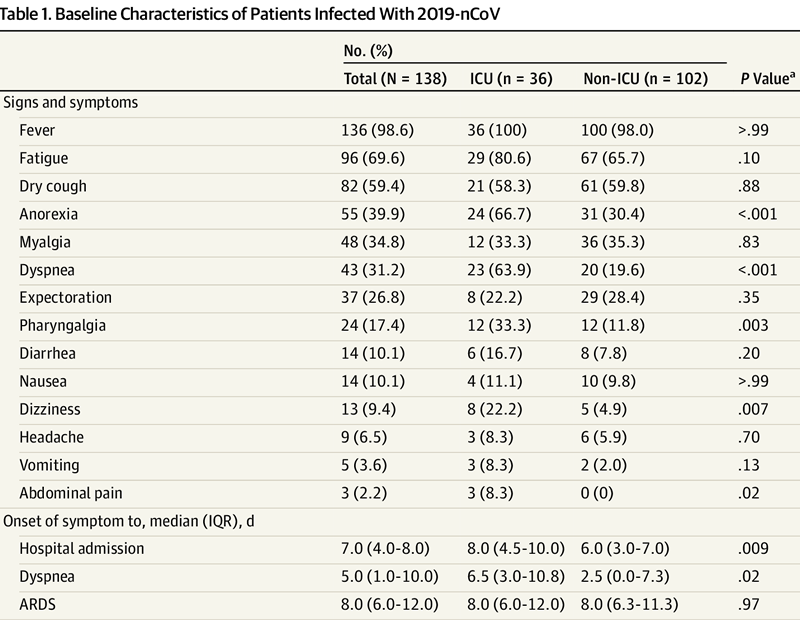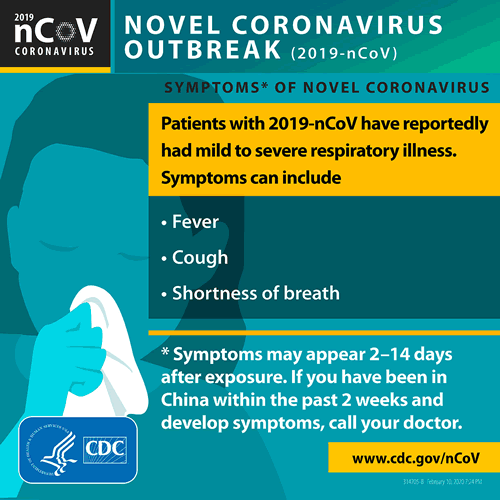Last updated: April 24, 2:00 GMT - We will continue to update and improve this page as we gather new information and details.
Symptoms of Coronavirus (COVID-19) - United States Centers for Disease Control and Prevention (CDC) [1]People with COVID-19 have had a wide range of symptoms reported – ranging from mild symptoms to severe illness. These symptoms may appear 2-14 days after exposure to the virus:
- Fever
- Cough
- Shortness of breath or difficulty breathing
- Chills
- Repeated shaking with chills
- Muscle pain
- Headache
- Sore throat
- New loss of taste or smell
See also:
COVID-19 typically causes flu-like symptoms including a fever and cough.
In some patients - particularly the elderly and others with other chronic health conditions - these symptoms can develop into pneumonia, with chest tightness, chest pain, and shortness of breath.
It seems to start with a fever, followed by a dry cough.
After a week, it can lead to shortness of breath, with about 20% of patients requiring hospital treatment.
Notably, the COVID-19 infection rarely seems to cause a runny nose, sneezing, or sore throat (these symptoms have been observed in only about 5% of patients). Sore throat, sneezing, and stuffy nose are most often signs of a cold.
Based on all 72,314 cases of COVID-19 confirmed, suspected, and asymptomatic cases in China as of February 11, a paper by the Chinese CCDC released on February 17 and published in the Chinese Journal of Epidemiology has found that:
See also: Death Rates by Existing Conditions
Pre-existing illnesses that put patients at higher risk:
That said, some otherwise healthy people do seem to develop a severe form of pneumonia after being infected by the virus. The reason for this is being investigated as we try to learn more about this new virus.
A man in his 40s in Japan:
A man in his 60s in Japan:
A man in his 40s in Japan:
A woman in her 70s, in Japan:
A woman in her 40s, in Japan:
A man in his 60s, in Japan:
Another patient, in China with a history of type 2 diabetes and hypertension:
First death in the Philippines (a 44-year-old Chinese thought to have had other pre-existing health conditions):
Using available preliminary data, the Report of the WHO-China Joint Mission published on Feb. 28 by WHO, [5] which is based on 55,924 laboratory confirmed cases, observed the following median time from symptoms onset to clinical recovery:
Among patients who have died, the time from symptom onset to outcome ranges from 2 - 8 weeks.
Common symptoms included:
(Wang et al study) [2] |
|
Fever |
98.6% |
Fatigue |
69.6% |
Dry cough |
59.4% |
The median time observed:

From: Clinical Characteristics of 138 Hospitalized Patients With 2019 Novel Coronavirus–Infected Pneumonia in Wuhan, China - JAMA, Wang et al., February 7, 2020
Fever |
98% |
Cough |
76% |
Myalgia (muscle pain) or Fatigue |
44% |
LESS COMMON SYMPTOMS: |
|
Sputum production (coughing up material) |
28% |
Headache |
8% |
Haemoptysis (coughing up blood) |
5% |
Diarrhea |
3% |
Signs and symptoms at admission (Chen et al study) [4] |
||
Fever |
83% |
|
Cough |
82% |
|
Shortness of breath |
31% |
|
Muscle ache |
11% |
|
Confusion |
9% |
|
Headache |
8% |
|
Sore throat |
5% |
|
Rhinorrhoea (runny nose) |
4% |
|
Chest pain |
2% |
|
Diarrhea |
2% |
|
Nausea and vomiting |
1% |
|
More than one sign or symptom |
90% |
|
Fever, cough, and shortness of breath |
15% |
|
The Canadian PHAC section dedicated to the 2019 novel coronavirus states that:
Symptoms have included:
In severe cases, infection can lead to death.
The UK National Health Service (NHS) section dedicated to Coronavirus (2019-nCoV) lists the following as the main symptoms of coronavirus:
The GOV.UK novel coronavirus guidance for the public page says:
The GOV.UK clinical guidance on Novel coronavirus (2019-nCoV): epidemiology, virology and clinical features notes that:
The Australian Government Department of Health informs that symptoms can range from mild illness to pneumonia, adding that some people will recover easily, while others may get very sick very quickly. According to their list of novel coronavirus symptoms, people may experience:
The CDC has published the following infographic on its Symptoms of Novel Coronavirus (2019-nCoV):

The WHO has issued an interim guidance on the clinical management of suspected cases in which it says that